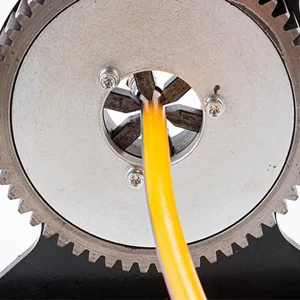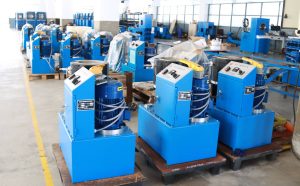Hydraulic hose crimpers are essential tools in various industrial applications, ensuring safe and secure connections between hydraulic hoses and fittings. These machines are responsible for attaching metal or plastic fittings to hoses used in hydraulic systems, providing tight, leak-free seals that are vital for the safe and efficient operation of hydraulic equipment. The function of a hydraulic hose crimper cannot be overstated, especially when it comes to preventing costly downtime or dangerous system failures. This article will explore what hydraulic hose crimpers are, how they work, and the critical factors to consider when choosing the right one for your business.
1. What Are Hydraulic Hose Crimpers and Why Are They Important?
Hydraulic hose crimpers are devices designed to crimp or attach fittings to hydraulic hoses. These fittings are crucial for ensuring that hydraulic fluid moves through the system without leaks. But here’s the kicker: the quality of the crimp determines the integrity of the entire hydraulic system. Poorly crimped hoses can result in leaks, reduced efficiency, and potential safety hazards.
The crimping process involves placing the hydraulic hose and fitting in the crimper, where the fitting is pressed tightly onto the hose under hydraulic pressure. This creates a secure, leak-proof connection. Hydraulic hose crimpers come in different types, ranging from manual to fully automated models. What’s the real story? The versatility and efficiency of these tools make them indispensable in industries like manufacturing, construction, and automotive repair.
When you choose a hydraulic hose crimper, it’s important to select one that meets your specific needs. Key considerations include the type of hose and fittings used, the required crimping capacity, and the desired level of automation. Ultimately, the right crimper will improve productivity, reduce downtime, and ensure the safety and reliability of your hydraulic systems.
| Key Feature | Importance | Application |
|---|---|---|
| Crimping Capacity | Ensures proper fit for hoses and fittings | Critical for safety and performance |
| Automation | Increases efficiency and reduces human error | Suitable for high-volume operations |
| Durability | Reduces maintenance needs and costs | Long-term use in harsh environments |
2. How Do Hydraulic Hose Crimpers Work?
A hydraulic hose crimper operates by using hydraulic pressure to press a fitting onto the end of a hydraulic hose. Ready for the good part? The process is straightforward but requires precision and the right crimper for the job. Here’s how it works:
First, the hydraulic hose and fitting are placed into the crimping tool. The crimper then uses hydraulic force to compress the fitting tightly around the hose, creating a secure seal. This process ensures that the hydraulic system remains leak-free, even under high-pressure conditions. What’s the real story? The hydraulic pressure applied during crimping ensures that the fitting is tightly and uniformly attached to the hose, which is crucial for preventing failures in the system.
Hydraulic hose crimpers typically offer adjustable pressure settings, allowing operators to customize the crimping force for different types of hoses and fittings. The machine may also include various crimping dies to accommodate various sizes and materials. This is where it gets interesting: with the right crimper, operators can achieve perfect crimps every time, ensuring consistent quality and safety.
| Crimping Mechanism | Function | Example |
|---|---|---|
| Hydraulic Pressure | Applies force to secure the fitting | Hydraulic pressurized systems |
| Adjustable Pressure | Customizes force for different hoses | Different hose materials and sizes |
| Crimping Dies | Accommodates various fitting sizes | Suitable for different hose types |
3. What Types of Hydraulic Hose Crimpers Are Available?
When shopping for a hydraulic hose crimper, you’ll come across different types of machines, each with its unique features and advantages. But here’s the kicker: choosing the right type of crimper can make a significant difference in your operation’s efficiency and safety.
The most common types of hydraulic hose crimpers are:
- Manual Crimpers: These are hand-operated machines that require the operator to apply pressure to crimp the hose and fitting together. Manual crimpers are often used for small-scale operations or low-volume work, where precision and control are more important than speed.
- Hydraulic Crimpers: These machines use hydraulic pressure to perform the crimping process. Hydraulic crimpers are more powerful than manual models and are ideal for medium to high-volume operations. They provide consistent results and are capable of handling larger hose sizes and tougher materials.
- Electric Crimpers: These crimpers combine hydraulic force with electric power, making them faster and more efficient than manual or standard hydraulic crimpers. Electric crimpers are suitable for high-volume industries that require rapid production rates without compromising on quality.
- Pneumatic Crimpers: Pneumatic crimpers use compressed air to generate the necessary pressure for crimping. They are often used in environments where electricity may not be available or desirable. Pneumatic crimpers are ideal for mobile operations and high-speed crimping tasks.
What’s the real story? Each type of crimper has its strengths and weaknesses, and the best choice depends on your specific needs, such as volume, hose size, and required precision.
| Crimper Type | Power Source | Best Use |
|---|---|---|
| Manual Crimpers | Hand-operated | Small-scale, low-volume operations |
| Hydraulic Crimpers | Hydraulic pressure | Medium to high-volume operations |
| Electric Crimpers | Electric power | High-speed, high-volume industries |
| Pneumatic Crimpers | Compressed air | Mobile and fast crimping tasks |
4. Why Should You Choose a Hydraulic Hose Crimper Over Other Tools?
Hydraulic hose crimpers offer distinct advantages over other crimping tools like manual crimping tools or older-fashioned methods. Ready for the good part? Here’s why hydraulic crimpers are the go-to solution for any business working with hydraulic systems:
Hydraulic crimpers are more efficient than manual tools because they rely on hydraulic pressure to perform the crimping, making the process faster and more consistent. This ensures that each crimp is uniform, which is essential for creating leak-free connections. Moreover, hydraulic crimpers can handle tougher materials and larger hose sizes that manual tools might struggle with.
What’s the real story? By investing in a hydraulic hose crimper, you can increase your productivity, reduce human error, and ensure that your hydraulic systems are functioning at their best. Hydraulic hose crimpers also offer a higher level of safety by reducing the risk of improper crimps, which could lead to leaks, ruptures, or system failures.
| Feature | Hydraulic Crimpers | Manual Crimping Tools |
|---|---|---|
| Speed | Fast, efficient crimping | Slower, more labor-intensive |
| Precision | Consistent, uniform crimps | Variable results depending on operator skill |
| Capacity | Handles large and tough hoses | Limited to smaller hoses |
5. What Are the Key Features of a High-Quality Hydraulic Hose Crimper?
When choosing a hydraulic hose crimper, there are several features that determine the overall performance and longevity of the machine. But here’s the kicker: a high-quality crimper should combine several key features to provide maximum efficiency and durability.
The first feature to look for is the crimping capacity, which defines the range of hose sizes the crimper can handle. It’s important to select a crimper that can handle both the largest hose sizes and the smallest fittings you’ll be working with.
What’s the real story? Durability is another crucial feature. A crimper made from high-quality materials like steel or aluminum will last longer and require fewer repairs. Additionally, precision is essential for creating tight, leak-proof crimps. A crimper with adjustable pressure and interchangeable dies will provide greater flexibility, allowing operators to work with different hose sizes and materials.
Lastly, safety features like emergency stop buttons, overload protection, and automatic shutoffs are essential for preventing accidents and ensuring the operator’s safety during the crimping process.
| Feature | Importance | What to Look For |
|---|---|---|
| Crimping Capacity | Handles various hose sizes | Adjustable capacity range |
| Durability | Long-term performance | Steel or aluminum construction |
| Precision | Ensures leak-proof crimps | Adjustable pressure and dies |
| Safety Features | Operator protection | Auto-shutoff, overload protection |
6. What Materials and Hoses Can Hydraulic Hose Crimpers Work With?
Hydraulic hose crimpers are versatile tools that can handle a variety of materials and hoses. Ready for the good part? Whether you’re working with rubber, PVC, or stainless steel hoses, the right crimper can handle them all. The material of the hose and fitting plays a significant role in choosing the appropriate crimper.
Rubber hoses are commonly used in general-purpose applications, while stainless steel hoses are more suitable for high-pressure systems and harsh environments. Some crimpers are specifically designed for certain materials, offering the necessary pressure and die configurations to ensure a secure fit. This is where it gets interesting: understanding the materials you’ll be working with can help you select the right crimper for the job, ensuring a tight and secure seal every time.
| Material | Best Crimper Type | Applications |
|---|---|---|
| Rubber | Hydraulic or manual crimpers | General industrial use |
| PVC | Hydraulic crimpers | Light-duty and flexible hoses |
| Stainless Steel | Hydraulic or electric crimpers | High-pressure systems and harsh environments |
7. How Do You Choose the Right Hydraulic Hose Crimper for Your Business?
Choosing the right hydraulic hose crimper for your business requires careful consideration of several factors. What’s the real story? The first step is determining your crimping needs based on the volume of work, the types of hoses you use, and the precision required.
Consider factors like crimping capacity, materials compatibility, and the level of automation required for your operation. If you need to handle high volumes of work, a fully automated hydraulic crimper will improve efficiency and reduce labor costs. Here’s the kicker: if your business works with a variety of hose sizes and materials, it’s worth investing in a versatile crimper with adjustable pressure settings and multiple dies.
Ultimately, selecting a hydraulic hose crimper should be based on your business’s specific requirements, balancing performance, cost, and durability.
| Consideration | What to Look For | Example |
|---|---|---|
| Crimping Capacity | Range of hose sizes | Large and small hoses |
| Material Compatibility | Types of hoses and fittings used | Rubber, PVC, stainless steel |
| Automation Level | Efficiency and production speed | Automated vs. manual crimping |
8. What Are the Benefits of Automatic Hydraulic Hose Crimpers?
Automatic hydraulic hose crimpers offer numerous advantages over manual models, making them a popular choice for high-volume businesses. Ready for the good part? The primary benefit of automatic crimpers is their ability to increase efficiency and reduce human error.
With automatic crimpers, the operator only needs to load the hose and fitting, and the machine takes care of the rest. This eliminates variability in crimping pressure and ensures consistent results every time. What’s the real story? Automated crimpers also save time by speeding up the crimping process, allowing businesses to produce more products in less time.
| Feature | Manual Crimper | Automatic Crimper |
|---|---|---|
| Speed | Slower, labor-intensive | Fast, efficient operation |
| Consistency | Varies by operator skill | Consistent, uniform crimps |
| Labor Requirements | Requires operator effort | Minimal operator involvement |
9. How Important Are Safety Features in Hydraulic Hose Crimpers?
Safety is a critical consideration when using hydraulic hose crimpers. This is where it gets interesting: hydraulic systems operate under high pressure, which can pose significant risks if proper precautions are not in place. Crimpers with safety features such as emergency stop buttons, overload protection, and automatic shutoffs help minimize accidents and protect the operator.
Accidents can occur if the crimping process is not properly controlled, leading to injuries or damage to the equipment. What’s the real story? Choosing a crimper with robust safety features can prevent accidents and ensure that workers are protected at all times.
| Safety Feature | Purpose | Example |
|---|---|---|
| Emergency Stop Button | Immediate shutdown of machine | Prevents dangerous situations |
| Overload Protection | Prevents over-crimping | Ensures safe crimping pressure |
| Automatic Shutoff | Stops crimping process during faults | Avoids system damage |
10. What Are the Common Problems You Can Encounter With Hydraulic Hose Crimpers?
Like any machinery, hydraulic hose crimpers are prone to problems over time. What’s the real story? The most common issues include:
- Inconsistent crimping results due to poor calibration
- Hydraulic pressure problems that prevent proper crimps
- Worn-out dies that cause uneven crimping
- Hydraulic fluid leaks or contamination
Ready for the good part? These issues can usually be prevented with regular maintenance, calibration checks, and replacing worn-out parts.
| Problem | Cause | Solution |
|---|---|---|
| Inconsistent Crimping | Poor calibration or worn-out dies | Regular calibration, die replacement |
| Hydraulic Pressure | Low or fluctuating pressure | Check hydraulic fluid levels and pressure settings |
| Fluid Leaks | Worn-out seals | Replace seals and check for leaks |
11. How Can You Extend the Lifespan of a Hydraulic Hose Crimper?
Proper maintenance is key to extending the lifespan of a hydraulic hose crimper. What’s the real story? Regular cleaning, lubrication, and part inspections are crucial to keeping the machine in optimal condition. Replacing worn-out parts and ensuring the hydraulic fluid remains clean and at the proper level will prevent premature wear and tear.
Here’s the kicker: keeping your crimper well-maintained not only increases its lifespan but also improves its performance and reliability.
| Maintenance Task | Benefit | Frequency |
|---|---|---|
| Regular cleaning | Prevents buildup and clogs | Weekly or after heavy use |
| Lubrication | Reduces wear on moving parts | Monthly or as needed |
| Part Inspection | Identifies worn-out components | Every 3-6 months |
12. How Do Crimper Accessories Impact Performance?
Accessories can significantly improve the functionality of a hydraulic hose crimper. This is where it gets interesting: accessories like dies, adapters, and gauges allow the crimper to handle a wider variety of hose sizes and materials. Interchangeable dies provide flexibility, while pressure gauges help ensure the correct crimping force is applied.
What’s the real story? By investing in the right accessories, you can enhance the versatility and efficiency of your hydraulic hose crimper, ensuring that it meets all of your operational needs.
| Accessory | Benefit | Example |
|---|---|---|
| Interchangeable Dies | Versatility for different sizes | Crimp various hose types |
| Pressure Gauges | Ensures accurate pressure | Calibrate for perfect crimps |
| Adapters | Works with different fittings | Expand compatibility |
13. How Does Price Affect the Selection of a Hydraulic Hose Crimper?
Price plays a crucial role in the decision-making process when selecting a hydraulic hose crimper. But here’s the kicker: while high-end crimpers may offer more features and better performance, they may not always be necessary for smaller businesses with lower production needs. Businesses need to assess their needs, budget, and expected workload before deciding on a crimper.
| Price Range | Features | Best Use |
|---|---|---|
| Budget ($500-$1,000) | Basic crimping capacity | Small businesses or infrequent use |
| Mid-range ($1,000-$3,000) | More advanced features | Growing operations |
| Premium ($3,000-$6,000) | High crimping capacity, automation | Large-scale operations |
14. What Are the Latest Trends in Hydraulic Hose Crimper Technology?
Hydraulic hose crimper technology has evolved significantly over the years. Ready for the good part? Modern crimpers are more automated and offer features like digital controls, real-time monitoring, and improved pressure regulation for enhanced performance.
What’s the real story? These advancements not only improve efficiency but also make it easier to achieve precise, high-quality crimps. With the introduction of smart technologies, the future of hydraulic hose crimpers looks promising, offering even more automation and improved performance.
| Trend | Benefit | Example |
|---|---|---|
| Automation | Increased efficiency | Faster, error-free crimping |
| Digital Controls | Precision and consistency | Real-time crimping adjustments |
| Smart Technology | Enhanced monitoring | Smart crimpers with sensors |
15. What Are the Maintenance and Repair Costs of Hydraulic Hose Crimpers?
The cost of maintaining and repairing hydraulic hose crimpers can vary depending on the machine’s complexity, usage, and the availability of parts. What’s the real story? Regular maintenance can reduce long-term repair costs, but businesses should still budget for potential repairs, especially for high-volume machines.
Ready for the good part? Investing in a high-quality crimper with reliable customer support and warranty coverage can help mitigate these costs over time.
| Maintenance Task | Cost Factor | Frequency |
|---|---|---|
| Routine Maintenance | Low cost for cleaning and lubrication | Weekly to monthly |
| Part Replacement | Moderate cost | Every 6-12 months |
| Major Repairs | High cost for major issues | As needed |
FAQ Section
Q1: What is a hydraulic hose crimper?
A hydraulic hose crimper is a machine used to attach fittings to hydraulic hoses, ensuring a secure, leak-free connection under high pressure.
Q2: How does a hydraulic hose crimper work?
A hydraulic hose crimper works by using hydraulic pressure to press a fitting tightly onto the end of a hose, creating a secure and leak-proof bond.
Q3: What materials can be used with a hydraulic hose crimper?
Hydraulic hose crimpers can handle hoses made from materials such as rubber, PVC, and stainless steel, and can crimp various sizes and fittings.
Q4: Why is safety important in hydraulic hose crimping?
Safety is critical because improper crimping can lead to accidents or system failures. Crimpers with safety features help protect the operator and equipment.
Q5: How can I maintain my hydraulic hose crimper?
To maintain a hydraulic hose crimper, clean it regularly, lubricate moving parts, and inspect for wear and tear. Replace any worn-out components as needed.




